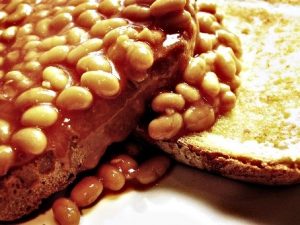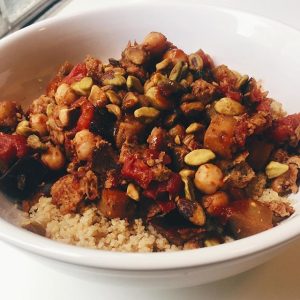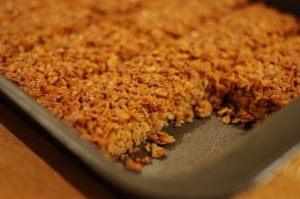This blog has been written by Joy Davies, a Welfare Consultant at Wellbeing Services.
Everywhere we look at the moment, there are memes and jokes about how people are surviving lockdown by munching their way through snacks to pass the time each day. We also know that these are strange times, with lots of us feeling isolated from friends and family, changes in routine and uncertainty for the future that can lead to dips in our mental health and feelings of wellbeing. But can we use the food we eat to support us in feeling good in body and mind during the lockdown?
The mental health charity, MIND, have done some brilliant research into the link between the food we eat and our mood. And it doesn’t have to be complicated! Simple steps we can all take can help us to give our body and brain the best chance of staying well every day!
This blog series will explore simple ways you can use food to boost your mood including:
Power Protein
Looking After Your Gut
Sneaky Ways to Get Your 5 a Day
Energy Boosts (Without the Caffeine…)
Today: Balance Your Blood Sugar
Drops in your blood sugar can leave you feeling tired, irritable and depressed. Eating little and often and choosing foods that release energy slowly will help to keep your blood sugar level and avoid highs and lows!
Slow release energy foods include:
- Pasta
- Rice
- Oats
- Wholegrain bread
- Cereal
- Nuts and Seeds
- Protein like meat and fish
Snacks and Quick Meal Ideas to Balance Your Blood Sugar:
- Peanut Butter on Granary Toast

- Banana and Yoghurt Smoothie with a handful of instant oats! (Check out these simple smoothie recipes)
- Pitta bread with hummus (Feeling fancy? Making hummus isn’t as complicated as you’d think. Find out how to make Hummus here)
- Beans on toast with a sprinkle of grated cheese
Easy-Cook Dinners for Balancing Your Blood Sugar
Super-Simple Spaghetti Bolognaise
(Serves 2, double quantities to serve 4)
Total Cost: £2.90
Equipment: Two saucepans or a frying pan/wok and a saucepan. Spoon for stirring. Kitchen knives and a chopping board.
250g Minced Beef or vegetarian Quorn Mince 
1 Tin Chopped Tomatoes
1 Veggie Stock Cube
1 Beef Stock Cube (or vegetarian “beef” stock cubes)
Whatever vegetables you have kicking about
A squeeze of tomato puree or ketchup
150-200g spaghetti, depending on appetite!
Optional: A sprinkle of grated cheese for serving
- Finely chop the vegetables you have – carrots, leeks, onions and peas all work really well. You can even use frozen mixed veg!
Tip: Carrot works really well grated as it cooks super quickly! - Fry off the mince beef until just browned – the meat should no longer look pink/raw. This should take about 3 minutes.
- If using onions or leeks, pop these in now to soften in the pan with the beef
- Add the tin of chopped tomatoes, the stock cubes and any other veg you want to use.
- Add a squirt of tomato puree or tomato ketchup for added richness
- Simmer for 15 minutes on low.
- Pop the spaghetti in a pan of boiling water with a pinch of salt and cook according to packet instructions.
- Drain the spaghetti and serve, adding a little grated cheese on top to taste!
Sweet and Spicy Moroccan-Style Casserole
(Serves 2, double quantities to Serve 4)
Total Cost: £2.68 including a new jar of Moroccan style seasoning
Equipment: Two saucepans. Spoon for stirring. A sharp knife or scissors to cut up the chicken. A sharp knife to cut up the carrots and any other vegetables you want to use. A chopping board.
Ingredients:
1 tin of chickpeas in water
1 tin of chopped tomatoes
1 Vegetable Stock Cube diluted in 200ml hot water
A carrot or two
Morrocan seasoning spice to taste
150g rice
Optional: Any other veg you have! Spinach works really well – frozen or fresh!
Optional: 1 Chicken Breast. The chickpeas will provide plenty of protein but you could always add a chicken breast if you can’t imagine a meal without meat!
- Finely chop or grate the carrots
- If using chicken breast, start by searing this in the pan with a little oil or butter. You should no longer see any raw, pink chicken – the edges of each piece should be white. This should take about 3 minutes.
- Put the chopped tomatoes, chickpeas, vegetable stock and carrots in a large saucepan.

- Optional: Add the seared chicken
- Bring to the boil and reduce to a simmer
- Add the Moroccan seasoning mix to taste
- Optional: add any other vegetables you want to add
- Simmer for 15-20 minutes
- Cook the rice according to packet instructions
- Serve and enjoy!
Fancy something sweet? Homemade flapjack
Homemade flapjack can give you a sweet fix while the oats slow down the release of the sugars into your blood.
Equipment: Something to bake them in – baking tray/baking tin/cake tin/glass heat-proof dish
Grease-proof paper/baking paper – don’t worry if you haven’t got this. You can always use some extra butter rubbed on the inside of the tin to stop them sticking. A saucepan and a spoon.
Ingredients:
150g butter or spread
100g/4 tablespoons golden syrup OR coconut oil OR honey
100g light brown sugar – but any sugar will do!
350g porridge oats
Optional: raisins, chopped nuts, chopped cherries, dark chocolate drops
- Preheat the oven to 180C
- Line a baking tin/tray with grease-proof paper or butter the inside

- Put the butter, syrup/coconut oil/honey and sugar in a saucepan and stir over a medium heat for 5 minutes until the butter has melted and the sugar has dissolved.
- Take off the heat
- Mix in the oats – Optional: Add any raisins/cherries/chocolate drops here.
- Tip the mixture into your tin and use a spoon to press it down evenly. This helps your flapjacks stay together when cutting them up!
- Back for 20-25 minutes
- Leave to cool, cut up and enjoy!
Final Thoughts:
Remember, think blood sugar when you grab something to eat! If something contains lots of sugar and not much else (think that big bar of chocolate….) it will spike your blood sugar, followed by a big drop. Of course still enjoy your sweet treats, but overall, aim for a treat that will balance your blood sugar out!
We would love to see pictures of what you’ve cooked! Tweet @UoEWellbeing using #foodandmood
Next time: Simple ways to sneak in 5 a day